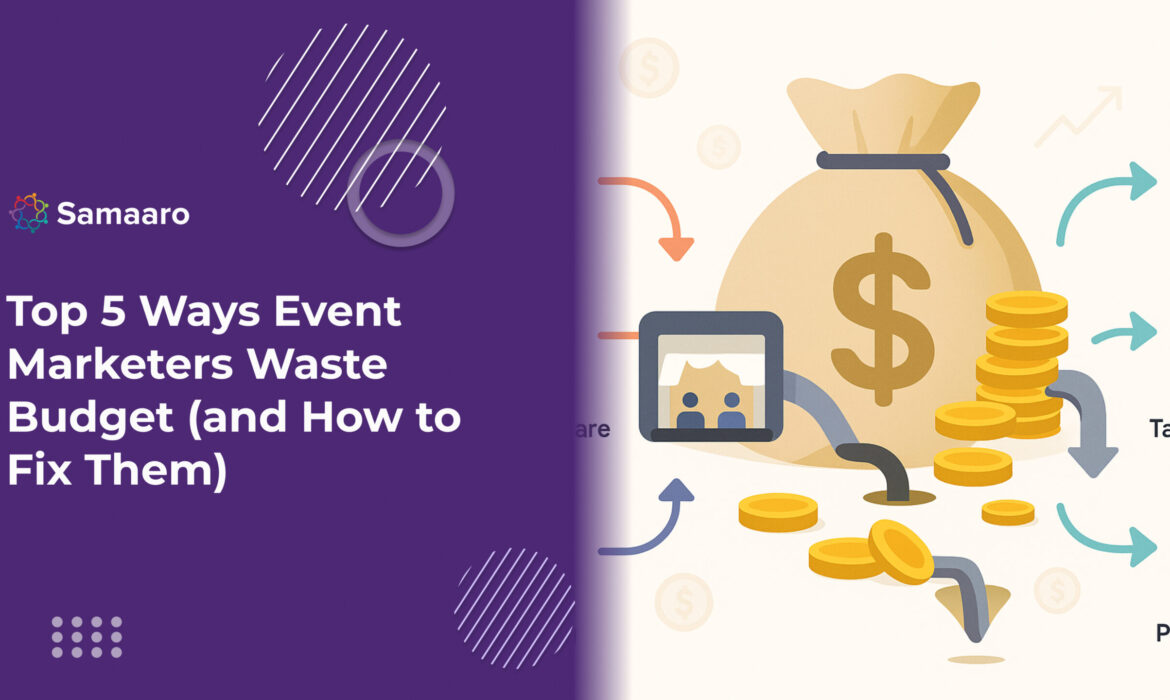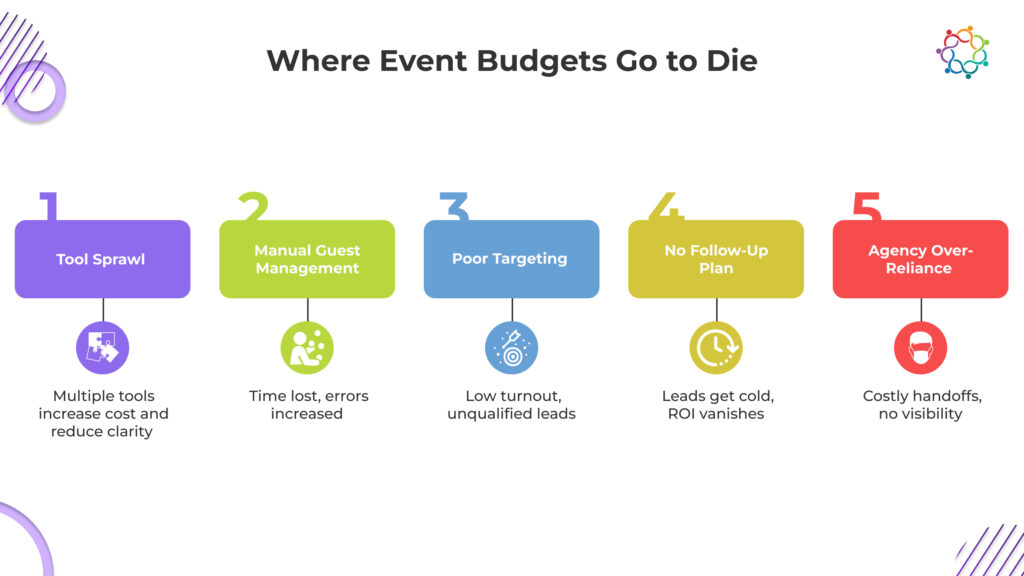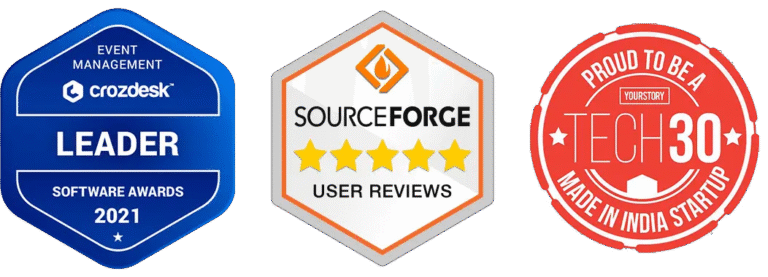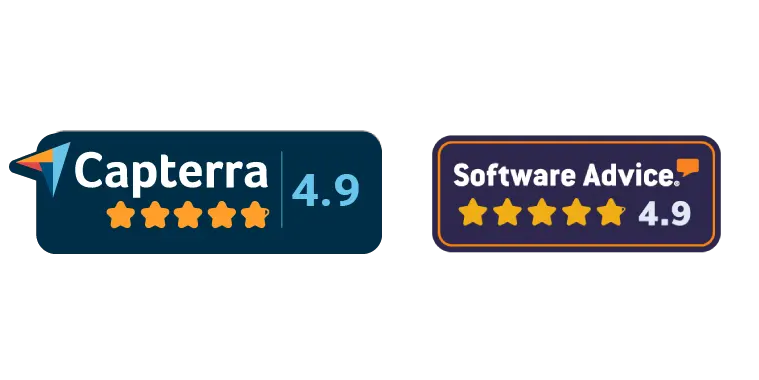Samaaro + Your CRM: Zero Integration Fee for Annual Sign-Ups Until 30 June, 2025
- 00Days
- 00Hrs
- 00Min

As we approach 2025, marketing leaders are feeling more pressure than ever. With smaller budgets and narrowed teams, CMOs are expected to deliver pipeline productivity, brand recognition, and customer engagement – simultaneously!
Events are still one of the most effective activations in the marketing arsenal. They are also among the most expensive. Without pre-planning and efficient execution, you might as well be flushing money down the toilet.
The problem is not only around cost, but waste. Many enterprise teams spend lakhs on events only to find under-leveraged assets, excessive manual work streams, and leads to nowhere.
So the path forward? Start to build a smarter approach that reduces waste and cost before it happens.

Let’s look at the five most common budget-wasting mistakes and how to fix them without expanding your team.
Mistake #1: Tool Sprawl Across the Event Lifecycle
One platform for registration, more email, another for check-in, a CRM, feedback, and perhaps an event app for attendee engagement! Before you know it, your event stack has expanded to a series of logins, hand-synced, and user license fees amassed.
Tool sprawl does not just inflate costs, it breaks the data. Teams waste countless hours piecing together insights from a disconnected event stack which effectively turns reporting on spend accountability into a guessing game.
The problem is even more profound when you consider the duplications built into this approach. There is a possibility that you’ll pay for several tools with overlapping features such as RSVP, reminders, or feedback collection, simply because no one had visibility across the entire stack.
Mistake #2: Manual Processes in Guest Management
Even in large corporations, it is surprisingly common to see guest management happening in Excel. Teams manually update RSVP lists, confirm attendees via WhatsApp, and then either print or export CSVs to print badges or follow-up emails.
This is not only inefficient, but it is also risky. One unintentional error could lead to a very embarrassing situation on the day of the event. Beyond that, manual processes obviously slow down reporting, slow down follow-ups, and make it more difficult to measure ROI.
If your team is still making phone calls to confirm attendance, or is still checking names manually when attendees arrive at the venue, you are wasting precious hours that could be automated.
Mistake #3: Bad Targeting = Empty Seats
You booked the venue, built out a great agenda, and sent 5,000 invites. But on event day, a third of the room is empty, or worse, you have flooded the room with people who are not decision-makers.
This is a result of sending invites to an outdated database list, irrelevant contacts, or broad audiences without segmentation.
The result is high cost per attendee, low conversion, and missed pipeline targets.
It’s not about an increased number of attendees. It’s about having the right attendees. Poor targeting wastes budget and also wastes your sales team’s time (when and if they follow-up post-event).
Mistake #4: No Post-Event Follow-up Plan
Your event ends, the team celebrates, and then silence.
Susan is not sending automated thank you emails, there is no lead scoring, no reminders for sales.All of the work invested in the event evaporates before it produces business impact. Without proper post-event strategy, you are simply paying for branding, not pipeline.
This is where ROI goes quietly to die: in the hours and days following the event when the momentum could have turned into meetings, but didn’t.
Mistake #5: Outsourcing Everything without Oversight
A good agency can be a tremendous partner, especially when you are executing complicated, labor intensive events, but when internal teams just hand everything over, with no oversight into what is being done, when, or at what cost, you can run afoul of the budget really soon.
You will usually run into duplicated efforts, slow feedback loops, and limited access to data. For a brand that is executing multiple events a year, this model is almost completely unsustainable.
Without a real-time dashboard or internal awareness, you will not only add costs every time you request a change, but also cannot identify nor implement optimizations.

Fix #1: Consolidate Your Event Stack into One Platform
Instead of running six different platforms for registration, RSVP, communications for guests, check-in, feedback, and to sync CRM, use an integrated event platform, like Samaaro.
Consolidating your event stack will automatically reduce subscriptions and manhours for data management. In addition, you will give your marketing teams a single dashboard to track performance in real-time, which lessens their necessary dependence on ops or IT.
Consolidated platforms also mitigate compliance risk, improve the experience for attendees, and enable you to manage everything from a single pane of glass.
Fix #2: Automate Your Workflows – Especially RSVP and Check-In
Stop manually sending invites one-by-one and confirming guests by hand! You can utilize automation to schedule RSVP emails to trigger automatically, remind attendees based on user actions, and check-in attendees through automatic dynamic QR codes.
For example, Samaaro allows you to see RSVP status in real-time; your team would be able to see who has or hasn’t signed up, it will also follow up automatically without any manual effort at all.
Two teams using an automated RSVP workflow can save up to 70% time and make fewer mistakes on event day.
Fix #3: Sync Events with a CRM to Make Your Targeting Smarter
By connecting your event platform to your CRM, you will target attendees smarter. You could send invites on lead score, industry, or prior engagement, to ensure that every seat is taken by someone worth converting.
Connecting a CRM also enables you to track in real-time who attended, engaged, and what attendees you have to follow up with. No more guessing. You will know what accounts are warming up, and which will require your attention after the event.
Fix #4: Create an Always-On Follow Up Machine
Event follow up doesn’t have to be manual. With some proper tools, you can have things like scheduling thank you emails, assigning leads or accounts to sales, and deploying feedback forms automatically once an attendee starts to check out.
Dashboards will show who engaged with your emails, who completed your surveys, and who dropped out, allowing marketing and sales teams to engage with even more knowledge during or after the event.If you’re unsure how to develop a feedback loop post-event, check out this guide on efficient event marketing budget management, which discusses how automation is key for conversion.
Fix #5: Monitor Agency ROI with Dashboards (or Smartly In-House)
It doesn’t matter if you have an agency or want to monitor things in-house, dashboards matter! The benefit of dashboards is the ability to see real-time data such as budget spend or vendor quality, attendee satisfaction, lead quality, and so on.
When you use something like Samaaro with campaign level reporting you can quickly show ROI to your CFO or leadership team without scouring the web for updates; visibility allows you to prevent scope creep, avoid unnecessary spend on vendors, and generally avoid campaigns that don’t deliver ROI.
If you host reputation events, consider doing more in-house using smart event tech. It will be more cost efficient long-term and allow for change in your operation rhythm.

In most cases budget waste is not about one horrendous error on your part, it’s about hundreds of small inefficiencies. Systems that don’t speak to one another, lists that are not updated, follow-ups that never go out.
But that’s the sweet spot, once you’ve removed these inefficiencies you will be off to the races with your ROI.
Here’s what real teams have seen through fixing their event ops:
Conclusion: Spend Smarter, Not Bigger
In 2025 efficient budget management is not about saving money, it’s about leveraging your tools and dollars in a manner that is beneficial to your corporation. For an enterprise event marketer moving toward less manual work and less spend is everything; it is the difference between the distinction of hosting a successful event or a revenue producing event.
The thoughtful process of auditing your technology stack and workflows in a timely and thorough manner must happen in order to know where the overlaps in your technology are and where you are duplicating work.
After you have undertaken this exercise, consolidating platforms, automating RSVP and check-in processes, and more robust follow-up post-event will expedite both time and money. You also will have real-time dashboards to know how much you are spending per event and other important data related to converting events into leads e.g., attendee satisfaction and quality of leads generated, so you are able to make more informed, more quickly, smarter decisions post event.
So, the best CMOs will not be those that spend the money we currently budget toward event experiences, but the ones that know how to spend the money that leads to the greatest return.

Built for modern marketing teams, Samaaro’s AI-powered event-tech platform helps you run events more efficiently, reduce manual work, engage attendees, capture qualified leads and gain real-time visibility into your events’ performance.


© 2025 — Samaaro. All Rights Reserved.